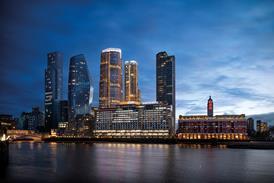Now that politicians of all parties have admitted spending has to be cut, the question is how much and where. Here Sarah Richardson makes the case for keeping capital programmes going. Overleaf, we mark your card for the upcoming party conferences
The Conservative party has given labels to each of the three main days of their upcoming conference. The first is broken politics, the second broken economy and the third broken society. Whether or not you agree with those categories, one thing is sufficiently clear: we are broke. The UK’s public borrowing is £16bn a month, interest on the national debt is £63bn a year and rising, and the projected deficit for the end of this financial year is likely to exceed Alistair Darling’s jaw-dropping estimate of £175bn.
Last week, the government finally admitted that cuts had to be made, which came as a huge surprise to nobody at all, least of all the construction industry. What is not yet known is how much will be cut, and where. Here we look at what is known about the parties’ intentions, and argue that wherever the cuts fall, they should spare the capital element of public spending.
What the parties are planning
It is likely that even the government does not know what it is going to cut, and by how much: at the end of last week Alistair Darling was reportedly in a series of one-to-one meetings with the heads of spending departments, the aim being to identify which of their programmes were more expendable than others. It was said that percentages were not discussed, but according to a recently leaked document, the Treasury is thinking along the lines of a reduction of 9.3% between now and 2014.
That debate will be continued in a party political context at Labour’s conference next week, before being spelled out in some detail in Darling’s pre-Budget report in November. The reason for that is partly to get the bad news out well before the election, and partly to force the Conservatives to show their hand.
As the Tories are favourites to win the next election, the contents of that hand is the subject of feverish speculation. The party has indicated that spending on the NHS and international development will be ringfenced, and they have committed themselves to scrapping ID cards. It is likely that spending on barracks and prisons will be well protected – one by the the war in Afghanistan, the other by the Daily Mail. In education, the means of delivering capital investment may well change, but it would take considerable courage to make serious cuts in the renewal programme. This leaves social housing and transport as the most vulnerable sectors. And when it comes to transport, the postponement of rail projects does not tend to stir strong emotions in voters and public sector unions – and the cancellation of roads can be quite popular.
It could take a generation to recover from significant capital spending cuts in areas like schools, housing, health and transport
Michael Ankers, CPA
Capital vs operational cuts
On the face of it, spending on construction is a sitting target. Cutting the operational budgets of health and education is politically expensive, especially if it involves making nurses and teachers redundant. For example, Ed Balls’ comment at the weekend that he was planning to make £2bn savings in areas such as teachers’ pay and staff numbers was met with a furious backlash. On the other hand, it is much easier to take away what has not actually been given – particularly if you happen to be an incoming Tory government with lots of political capital to spend and no ties to the last regime’s pet projects.
The second biggest heading on the public spending ledger (after the Department of Work and Pensions) is the £109bn that goes to the Department of Health. Of this money, £6.1bn (5.5%) is for capital investment. If we take the 10% figure as a guide, the saving would be a fairly insignificant £600m, but the cost would be the equivalent of cutting the money spent on building hospitals under the the Procure 21 framework by 80% (see below).
Of the £63bn spent by the Department for Children, Schools and Families, £9.1bn (12.3%) is capital investment. A 10% cut here could be achieved by shelving the primary capital programme for two years, but that would mean no new primary schools or improvements to old ones.
Michael Ankers, chief executive of the Construction Products Association, says: “It could take a generation to recover from significant capital spending cuts in areas like schools, housing, health and transport. You’d be harming long-term prospects for short-term benefits.” He adds that the UK’s population is expanding by 0.5% a year. “Some of the extra people will be children.You’ve got to find education places now, not look at it when they’re five.”
Capital spending makes up a much larger proportion of the budget for housing (62%). This might look like a tempting target, but again there are social arguments for not cutting back the programme. Jonathan Hook, global head of engineering and construction at Pricewaterhouse Coopers, says: “I’d think the social housing market is one area where the government would want to protect investment. There is a real need, and it’s not going to go away.”
I suspect we will not see large-scale cancellations, but we will see them slipping in the light of inevitable budgetary constraints
Jonathan Hook, Pricewaterhouse Coopers
Transport is a more difficult case to make, as there are several big, one-off projects such as Crossrail that could deliver fast savings if they were shelved. But this could sit awkwardly with the government’s need to reduce carbon emissions by moving more people using a high-speed, electrified rail network. In the area of rail improvements, the argument is also about whole-life costing. “You need to maintain the asset or you will end up with a bigger expenditure going forward,” says Ankers. “We’ve learned that lesson in the past. It would be like the late nineties, where you had a poor quality road network and it led to lots of repairs.”
He makes the same point about the healthcare sector. “We have caught up a lot in the past 10 years, but we need to develop them in response to medical practice. We mustn’t get behind again.”
According to Hook, one of the strongest arguments for continuing build programmes in any sector is the whole-life costing argument. “It’s a fact that old buildings are not as efficient,” he says. “It may be cheaper to replace than to maintain them.”
Then there are the costs of stopping and starting programmes. The �ڶ����� Schools for the Future initiative, for example, is starting to deliver cheaper costs because it allows construction firms and their suppliers to plan in the long term. “You get a better price and much better approach to delivery and innovation,” says Ankers.
There are also suggestions that materials companies, in particular, would turn their back on the UK market if there were a break in the pipeline of work. “Many are owned by foreign companies and don’t have a patriotic instinct towards the UK,” says Ankers. “If there’s a genuine belief that plants they’ve closed down will not have the work to re-open, they will look instead at France, Germany and the Netherlands.”
Hook says that one priority for the government as it tries to balance the arguments against cutting with the need for savings is to aid the recovery of the PFI. “I think that’s the key. Maybe part of the solution is for the new government to find ways that the public sector can underwrite part of the risk and make it more attractive for lenders to enter the market more quickly.”
He thinks lending should improve, but in the meantime the government should not let its programmes slide. “It ought to pick up, but in the absence of that the government does need to find ways to continue its investment programme, and look at whether it can justify making savings now in the context of the future. I suspect we will not see large-scale cancellations, but we will see them slipping in the light of inevitable budgetary constraints.”
Whitehall’s budget 2010/11: Operational vs capital spending
Education
Department for Children, Schools and Families and Department for Innovation, Universities and Skills.
Total £80.3����
Capital £9.9bn (12.3%)
Main capital programmes
- �ڶ����� Schools for the Future and the city academies will spend £55bn over the next 24 years on renewing 3,500 secondary schools. It is worth about £5bn a year.
- The primary capital programme will spend £7bn by 2023 on renewing more than 1,500 primary schools; £1.9bn is to be spent by April 2011. About £500m a year is scheduled to be spent after that.
If they cut this …
Cutting by 10% would save up to £1bn, but that could mean losing one-fifth of all secondary school projects or putting the primary programme on hold for two years.
Health
Department of Health
Total £109.8����
Capital £6.1bn (5.5%)
Main capital programmes
- Express LIFT: £1bn on primary care units and community hospitals, with framework contractors to be appointed to 20-year PPP deals.
- Procure 21+: The successor to Procure 21 is to spend £3.7bn between 2010 and 2015 on hospital and mental health schemes – that adds up to £750m a year.
If they cut this …
Cutting by 10% would save about £600m, but that could mean halving the number of primary care units built each year or cutting the hospital building programme 80%.
Transport
Total £14.5����
Capital £8.1bn (56%)
Main capital programmes
- Crossrail: £16bn rail link between now and 2016, with about £5bn of government funding.
- Rail upgrades: £15bn of funding between 2007 and 2012, including the £5.5bn Thameslink upgrade in London.
- Highways Agency: new road building programme worth about £725m a year.
If they cut this …
Cutting by 10% would save £800m, but this could mean reducing the rail upgrade programme by 25% or abandoning Crossrail.
Housing and regeneration
Total £12.1����
Capital £7.5bn (62%)
Main capital programmes
- In the housing green paper, £8bn was pledged for social housing over three years to deliver 210,000 homes by 2010/11.
- Regional development agencies: capital funding of about £1bn a year.
If they cut this …
Cutting by 10% would save £750m a year; this could mean building 2,000 fewer affordable homes a year or reducing regeneration funding 75%.
Methodology
The figures are from the last CSR and relate to 2010/11. Using the 10% figure from the Treasury document, we’ve looked at what could happen if this were applied to annual capital spend, taking the cost from current spending programmes to give an idea of the impact.
�ڶ����� goes to the parties
Construction is going to be much discussed at Conservative and Labour conferences this year. �ڶ����� will be reporting from both events at www.building.co.uk – but so you know what to look out for, here’s a quick glance at some of the key speeches and events.
Labour
Sunday to Wednesday, 27-30 September
Main stage
Monday will be the day of major interest for construction on the Labour conference main stage, with sessions on prosperity and work, the green future and creating sustainable communities. It will be left until Wednesday afternoon, however, for Ed Balls to top up his revelations on £2bn education spending cuts with any more detail.
On the fringes …
Sunday
17.45 Back to the Future: Co-operatives and Mutually Affordable Homes.
Housing minister John Healey and former construction minister Nick Raynsford lead the debate. Hosted by Labour Housing Group and the Co-Operative Group.
Monday
12.45 Public Services in a Cold Climate – What Should be the Priorities?
Lord Mandelson and Robert Chote of the Institute for Fiscal Studies address the biggest question of the moment.
Tuesday
12.30 Planes, Trains and Communities – �ڶ����� a Sustainable Thames Gateway
Transport minister Paul Clark and (subject to confirmation) Shahid Malik, the minister responsible for the Thames Gateway, discuss the latest developments on Britain’s biggest regeneration scheme. Chaired by Lord Falconer and hosted by the Thames Gateway All Party Group.
Wednesday
13.00 Regeneration in a Downturn – a Different Future?
Communities secretary John Denham is expected to join the panel alongside Clive Betts, the chair of the All-Party Urban Development Group. Hosted by the Smith Institute, King Sturge and Eversheds.
Conservatives
Monday to Thursday, 5-8 October, Manchester
Main stage
The Tories have set out their stall with the names given to their three main conference days, all of which refer to mending things that are broken. The second day of the conference, Tuesday (Rebuilding our Broken Economy), will be the most important for the construction industry. In the morning, Grant Shapps, the shadow housing minister, and Theresa Villiers, the shadow secretary of state for transport, take the stage.
Commentators will be watching for any hints on the future of the UK’s rail programme, including Crossrail – as well as any information on Tory commitment to affordable housing initiatives. George Osborne, Philip Hammond and Kenneth Clarke will speak over lunchtime. Greg Clark, the shadow energy secretary and Nick Herbert, the shadow environment secretary, will outline Tory plans for a green economy from mid-afternoon. However, you’ll have to wait until Wednesday (Mending our Broken Society) for any detail on the school building programme, courtesy of shadow education secretary Michael Gove.
On the fringes …
Monday
17.30 Housing crisis – What kind of recovery?
Grant Shapps and David Pretty are among those going head-to-head on the best way forward for housebuilding. Hosted by the Smith Institute, the Town and Country Planning Association, the Construction Products Association and the Centre for Social Justice.
Tuesday
17.00 Funding our future: Can we afford to put national infrastructure delivery on hold?
The panel for this debate includes Phil Hammond, shadow chief secretary to the Treasury. Hosted by the Spectator with CBRE and DLA Piper.
Wednesday
08.00 �ڶ����� a Better Britain: The Construction Profession’s Contribution
A chance for the industry to put forward its case for being the cornerstone of economic recovery. Hosted by the Construction Industry Council.



























No comments yet